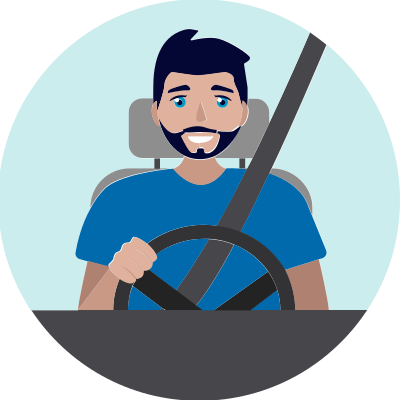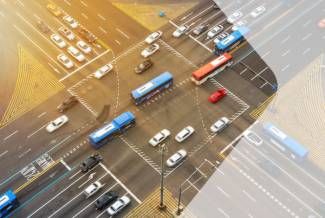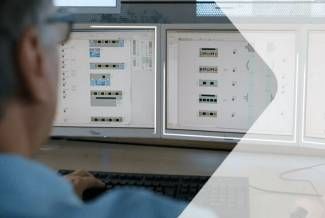Autonomous Driving:
Levels 1 to 5 explained
For many, autonomous driving is the long-awaited future of transportation. Especially because it promises two things: more time and more efficiency. Once vehicles drive autonomously, the time that would otherwise be spent behind the wheel can be used for other things. At the same time, more efficient driving reduces CO₂ emissions – and traffic congestion can be avoided more easily.
But does technological progress really offer realistic, near-term possibilities for autonomous driving? The 5 levels of autonomous driving shed light on this.
Autonomous Driving:
5 Levels and their Definitions
Autonomous driving is defined by the fact that highly developed driving systems analyze the environment and react to it independently. Depending on how far this development has progressed and how autonomously the car drives, it is assigned to a certain level.
The essential foundations for this are made up of the following technologies:
- Vehicle to Infrastructure (V2I) – the sensing of infrastructure by driver assistance systems.
- Vehicle to Vehicle (V2V) – the exchange of information between vehicles
- Vehicle to Cloud (V2C) – the connection of a vehicle to a cloud system
- Vehicle to Pedestrian (V2P) – the communication with pedestrians via mobile communications
AI, cameras, laser, ultrasonic, lidar sensors, GPS and radar systems and self-learning all contribute to the ability of a vehicle to drive autonomously.
The interaction of these sensors and communication systems thus conditions a vehicle's ability to operate autonomously on the road. The progress of these systems also influences the 5 levels of autonomous driving.
What exactly are the 5 levels? The Society of Automotive Engineers (SAE) has defined a scale with six levels of autonomous driving - from level 0 (no automation) to level 5 (full automation). In principle, this involves the vehicle's capabilities for perception, decision-making and control.
This definition is used by many experts, governments and authorities worldwide.
These 5 levels apply to autonomous driving
How independently a vehicle can move in road traffic is determined by its assignment to one of the 5 levels. These determine whether a driver can, for example, briefly take his or her attention off the road or whether he or she can, for example, sit in the back seat and leave everything else to the vehicle.
Level 0: Driver Only

The driver takes control permanently from start to finish. Despite support from various systems such as ABS, level 0 applies to the vehicle.
Level 1: Assisted Driving

- The driver takes control.
- The traffic must be kept in view continuously.
- The driver is liable for certain accidents, damages and violations of traffic regulations.
- Support from individual assistance systems is possible.
Level 1 is part of everyday life. Driving assistance systems such as cruise control, lane change assist or lane keep assist (LKAS) or automatic adaptive cruise control (ACC) ensure that the selected speed is maintained, the car stays exactly in its lane and sufficient distance is kept between two vehicles.
However, these systems only intervene to a limited extent. Therefore, control and thus responsibility always remain with the driver.
Good to know: Manufacturers such as BMW and Audi are working at this level on driver assistance systems such as:
- Intersection Assistant (warns of approaching cross traffic).
- Active cruise control with stop & go (independently regulates the distance between vehicles)
- Rear-end collision and passenger warning with city braking function (designed to prevent collisions through automatic braking)
Level 2: Partly Automated

The driver takes control.
The traffic must be kept in view at all times.
The driver is liable for certain accidents, damages and violations of traffic regulations.
The vehicle intervenes at short notice under certain conditions, brakes and accelerates.
In stage 2, more advanced functions are used. These include steering and lane guidance assist, traffic jam assist and remote-controlled parking assist. These make everyday traffic life easier by independently maintaining the lane on the highway, braking, accelerating or even parking automatically in tight parking spaces without the driver's intervention.
Level 2 driver assistance systems can take the wheel in a partially automated manner. However, this does not mean that the driver is allowed to turn his attention away from the traffic situation. He remains in control at all times and thus responsible for traffic safety.
Good to know: Vehicle systems that support autonomous driving levels 1 and 2 include Tesla Autopilot, Mercedes' Distronic Plus, the steering assistant in the Mercedes S-Class and E-Class, and the adaptive driving assistant in the Audi Q7.
Level 3: Highly Automated

The driver is allowed to turn his attention away from the traffic for a short period of time.
Depending on the model and manufacturer's specifications, the car drives independently to a certain extent.
The driver must be able to quickly resume control after being prompted by the system.
Drivers are only responsible if they ignore the system's indications.
If vehicles are capable of third level autonomous driving, drivers still have to sit behind the wheel, but are allowed to be distracted. This means that talking on the phone or watching a movie are permitted, for example. In critical situations, such as detours or bottlenecks at construction sites, the system will alert the driver to take the wheel again.
Legal and ethical issues arise here. The system typically sounds an alarm when a situation it cannot assess is imminent. However, the time left for the driver to take back the wheel is too short for the driver to fully evaluate the situation. If the driver does not react, the hazard warning lights are activated and the vehicle brakes.
Gut zu wissen: Seit 2023 dürfen in Deutschland unter bestimmten Voraussetzungen automatisierte Fahrzeuge der Stufe 3 bis zu 130 km/h schnell fahren. Die Aufmerksamkeit darf sich kurz von der Straße abwenden – z. B. um eine SMS zu lesen. Allerdings muss der Fahrer innerhalb von 10 Sekunden wieder die Kontrolle über das Fahrzeug übernehmen können.
Good to know: Since 2023, Stage 3 automated vehicles in Germany are legally allowed to drive at speeds of up to 130 km/h under certain conditions. Attention may briefly turn away from the road – for example, to read a text messages. However, the driver must be able to take control of the vehicle again within 10 seconds.
Level 4: Fully Automated

- The driver does not have to steer.
- Drivers must still be able to drive and take over the wheel in an emergency.
- The vehicle can operate fully autonomously on certain routes (e.g., highway) (even without occupants).
- The system knows its limits and is ready to come to a safe state in accordance with the rules at any time.
- Driver or passengers are not liable for violations of traffic regulations or damage during the journey.
Autonomous driving in higher classes offers significantly more comfort than driving in conventional vehicles. Passengers are even allowed to sleep, use their smartphone, read or play chess.
Level 4 can be regarded as a preliminary stage to fully autonomous driving: The vehicle can already navigate through traffic almost independently and has systems that can assess more complex traffic situations and act accordingly.
The driver should still be able to take the wheel. However, since sleeping at the wheel is allowed, the driver may not react. In this case, the hazard warning lights are activated and the vehicle is transferred to a safe state (e.g. parking).
Level 5: Autonomous

- There are no more drivers, only passengers.
- The car can move through traffic on its own, even without occupants.
- The systems are able to assess all traffic situations and traverse them safely.
- Passengers are not responsible for damage or violations of traffic regulations.
Unlike the other levels, level 5 no longer requires a driver who is capable of driving. This results in the greatest advantages of autonomous driving, e.g. active participation in road traffic by people who cannot or are not allowed to drive due to a handicap.
Good to know: The technical requirements for Level 5 autonomous driving are very high. For this reason, it is expected that in the beginning, regulations will be introduced, which will only allow vehicles to participate in road traffic at low speeds.
Lösungen von SWARCO
Conclusion: Autonomous driving up to level 5 will take time
Level 5 autonomous driving, in which the vehicle can operate completely without human intervention, is not yet available across the board. In any case, a vehicle only becomes truly autonomous at SAE level 4. It will probably be some time before autonomous driving arrives. Forecasts vary, for example:
- The Boston Consulting Group predicts that about a quarter of all new cars sold will be fully autonomous by 2035.
- A study by Roland Berger assumes that around 25 percent of all new cars sold will be able to drive autonomously by 2030.
Last but not least: Only vehicles up to level 2 or 3 are currently on the market. However, the technology has the potential to improve the safety and efficiency of traffic and increase mobility for people with limited mobility.
FAQ
The generally applicable, internationally recognized definition was created by the Society of Automotive Engineers (SAE). The following 6 levels were defined:
- Level 0: no automation
- Level 1: Assistance system (e.g. cruise control)
- Level 2: Partial automation (e.g. lane departure warning system)
- Level 3: Conditional automation (constant intervention required)
- Level 4: High automation (certain driving situations possible without driver)
- Level 5: Full automation (all driving situations without driver)
Currently, only vehicles that enable autonomous driving at level 2 to 3 are on the market. However, technological advances are significant. The potential to soon improve the safety and efficiency of traffic through autonomous driving in higher SAE classes exists.
According to Christoph Stiller, head of the Institute of Measurement and Control Engineering at the Karlsruhe Institute of Technology (KIT), it is possible that there will be more automated cabs and buses on German roads from 2025. Tobias Hesse from the Institute of Transportation Systems Engineering at the German Aerospace Center (DLR) predicts that even automated trucks on highways are conceivable from 2030.

STAY INFORMED
GET OUR NEWSLETTER!
Subscribe to our ITS / Smart Mobility Newsletter and receive regular updates on trends, developments, solutions and events.




